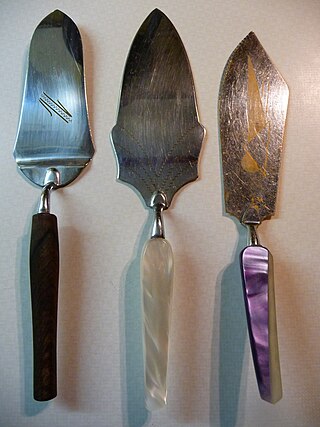
A palette knife is a blunt tool used for mixing or applying paint, with a flexible steel blade. It is primarily used for applying paint to the canvas, mixing paint colors, adding texture to the painted surface, paste, etc., or for marbling, decorative endpapers, etc. The "palette" in the name is a reference to an artist's palette which is used for mixing oil paint and acrylic paints.
A spatula is a broad, flat, flexible blade used to mix, spread and lift material including foods, drugs, plaster and paints.

Table setting or place setting refers to the way to set a table with tableware—such as eating utensils and for serving and eating. The arrangement for a single diner is called a place setting. It is also the layout in which the utensils and ornaments are positioned. The practice of dictating the precise arrangement of tableware has varied across cultures and historical periods.

Icing, or frosting, is a sweet, often creamy glaze made of sugar with a liquid, such as water or milk, that is often enriched with ingredients like butter, egg whites, cream cheese, or flavorings. It is used to coat or decorate baked goods, such as cakes. When it is used between layers of cake it is known as a filling.

A trowel is a small hand tool used for digging, applying, smoothing, or moving small amounts of viscous or particulate material. Common varieties include the masonry trowel, garden trowel, and float trowel.

Various customary etiquette practices exist regarding the placement and use of eating utensils in social settings. These practices vary from culture to culture. Fork etiquette, for example, differs in Europe, the United States, and Southeast Asia, and continues to change. In East Asian cultures, a variety of etiquette practices govern the use of chopsticks.

Kitchenware refers to the tools, utensils, appliances, dishes, and cookware used in food preparation and the serving of food. Kitchenware can also be used to hold or store food before or after preparation.

A kitchen knife is any knife that is intended to be used in food preparation. While much of this work can be accomplished with a few general-purpose knives — notably a large chef's knife and a smaller serrated blade utility knife — there are also many specialized knives that are designed for specific tasks such as a tough cleaver, a small paring knife, and a bread knife. Kitchen knives can be made from several different materials, though the commonest is a hardened steel blade with a wooden handle.
The spurtle is a wooden Scottish kitchen tool, dating from the 15th century, that is used to stir porridge, soups, stews, and broths.

Table manners are the rules of etiquette used while eating and drinking together, which may also include the use of utensils. Different cultures observe different rules for table manners. Each family or group sets its own standards for how strictly these rules are to be followed.

A putty knife is a specialized tool used when glazing single glazed windows, to work putty around the edges of each pane of glass. An experienced glazer will apply the putty by hand, and then smooth it with the knife. Modern insulated glazing may use other ways of securing the glass to the window frame.

Spackling paste or spackle is a putty used to fill holes, small cracks, and other minor surface defects in wood, drywall, and plaster. Typically, spackling is composed of gypsum plaster from hydrated calcium sulfate and glue.

A kitchen scraper is a kitchen implement made of metal, plastics, wood, rubber or silicone rubber. In practice, one type of scraper is often interchanged with another or with a spatula for some of the various uses.

A fish slice is a kitchen utensil with a wide, flat blade with holes in it, used for lifting and turning food while cooking. It may be called a slotted spatula or a turner or flipper. The utensil was originally designed as a serving piece rather than a cooking implement.

Hacking or side knives may be considered as either light hatchets or heavyweight knives.

Kata-kat or taka-tak is a meat dish popular throughout Pakistan. It is a dish originating from Karachi, Pakistan made from offal, including testicles, brain, kidney, heart, liver, lungs and lamb chops in butter. The dish's name is an onomatopoeia from the sound of the two sharp blades that hit the griddle as they cut up the meat. It is still an open question whether the correct name is tak-a-tak or kata-kat.

A cake and pie server, also called a cake shovel, pie knife, crépe spade, quiche trowel, pie-getter, pie lifter, pie spatula, cake knife, or cake slice is a serving utensil used in the cutting and serving of pies and cakes. Some cake and pie servers have serrated edges. Another use for the utensil can be to serve pizza.

Kaledo is a traditional cow's trotters soup served in spicy broth, from Donggala regency, Central Sulawesi, Indonesia. Per its name, the meat used in this particular food is cow's feet and its marrow. The dish originated from Donggala, and from there spread around Sulawesi.















